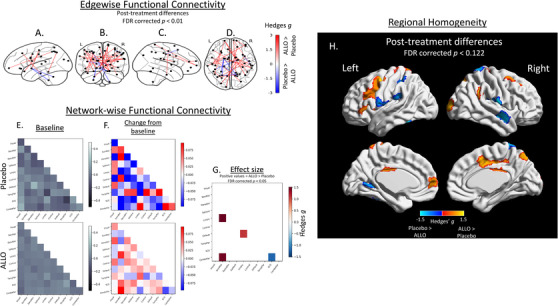FIGURE 3.

Impact of allopregnanolone (ALLO) on inter‐ and intra‐regional functional connectivity. Post‐treatment group‐wise differences in functional connectivity were evaluated at a region‐to‐region (“edge‐wise”) (A–D), network‐wise (E–G), and within‐region (“Regional Homogeneity”) (H) level using an atlas‐based approach (n = 473 total regions) and are reported as Hedges’ g effect sizes. A total of 32 edges exhibited large (|g| > 1.80; false‐discovery rate (FDR)–corrected P < .01) differences, with 25 edges exhibiting greater connectivity in the ALLO group. These edge‐wise connections are overlaid on the left hemisphere surface (A), a coronal view (B), the right hemisphere surface (C), and an axial view (D). These regions were additionally assigned to one of 11 large‐scale networks (E). Simple differences from baseline (E) to post‐treatment in network‐wise functional revealed general patterns of decrease in the placebo group (F, top) and limited changes or increases in the ALLO group (F, bottom). Baseline‐adjusted network models revealed larger increases in cross‐network functional connectivity between the limbic network and both the default mode and somatomotor networks, and decreases in cerebellar‐subcortical gray matter in the ALLO group compared to the placebo group (|g| > 1.16; FDR corrected P < .05)(G). Finally, ALLO was associated with larger increases (g > 0.74) in regional homogeneity in a total of 20 regions, including the prefrontal, posterior cingulate, and precuneus regions, whereas larger increases (g > 0.89) in the placebo group were observed in nine regions, including those associated with the bilateral somatomotor and dorsal attention networks (H). These regions with large differences were significant at FDR corrected .082 < P < .122 level
